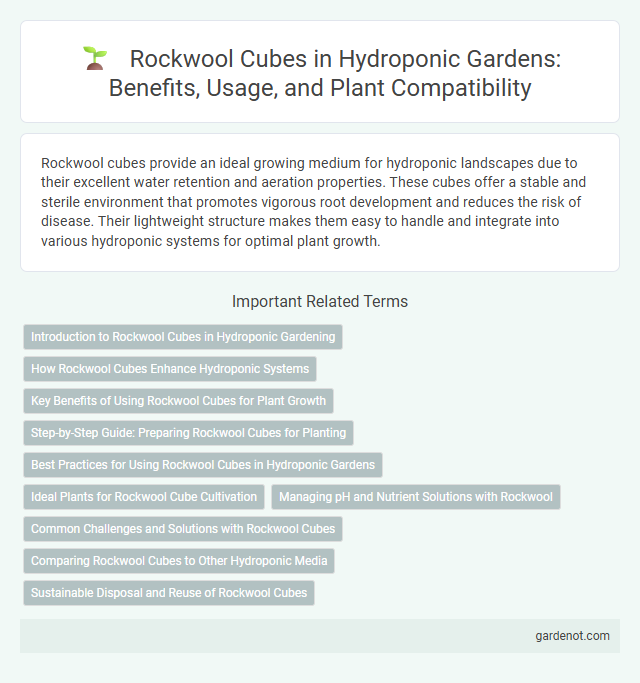Rockwool cubes provide an ideal growing medium for hydroponic landscapes due to their excellent water retention and aeration properties. These cubes offer a stable and sterile environment that promotes vigorous root development and reduces the risk of disease. Their lightweight structure makes them easy to handle and integrate into various hydroponic systems for optimal plant growth.
Introduction to Rockwool Cubes in Hydroponic Gardening
Rockwool cubes are a popular growing medium in hydroponic gardening due to their excellent water retention and aeration properties. Made from spun molten rock fibers, these cubes provide an optimal environment for seed germination and root development by maintaining consistent moisture levels while allowing adequate oxygen flow. Their inert nature ensures no interference with nutrient mixtures, promoting healthy plant growth in soilless systems.
How Rockwool Cubes Enhance Hydroponic Systems
Rockwool cubes significantly improve hydroponic systems by providing optimal water retention and aeration, which ensures consistent root oxygenation and growth. Their inert and pH-neutral properties prevent nutrient imbalances, promoting healthier plant development. These cubes also offer excellent stability and ease of transplanting, making them ideal for efficient and scalable hydroponic cultivation.
Key Benefits of Using Rockwool Cubes for Plant Growth
Rockwool cubes offer superior water retention and aeration, creating an ideal environment for healthy root development in hydroponic systems. Their sterile and pH-neutral properties reduce the risk of diseases and ensure consistent nutrient delivery, promoting vigorous plant growth. Efficient moisture management and structural stability help optimize space and increase crop yields in hydroponic landscapes.
Step-by-Step Guide: Preparing Rockwool Cubes for Planting
Soak Rockwool cubes in pH-balanced water (5.5-6.5) for at least 30 minutes to stabilize pH levels essential for nutrient absorption. Drain excess water to prevent waterlogging, ensuring proper aeration for seedling roots. Insert seeds into pre-cut holes or create gentle indentations in the cube to facilitate optimal root growth in hydroponic systems.
Best Practices for Using Rockwool Cubes in Hydroponic Gardens
Rockwool cubes provide excellent aeration and water retention, making them ideal for hydroponic gardens. To maximize growth, pre-soak cubes in pH-balanced water (5.5 to 6.5) before planting seeds or seedlings. Maintain consistent moisture without oversaturation to prevent root rot and promote healthy root development.
Ideal Plants for Rockwool Cube Cultivation
Rockwool cubes provide an excellent growing medium for leafy greens such as lettuce, spinach, and kale due to their superior water retention and aeration properties. Herbs like basil, mint, and cilantro thrive in Rockwool cubes, benefiting from the consistent moisture and root oxygenation. Additionally, Rockwool cubes support the cultivation of strawberries and tomatoes, offering stable root environments essential for hydroponic fruiting plants.
Managing pH and Nutrient Solutions with Rockwool
Rockwool cubes provide an inert and stable growing medium, allowing precise control over pH and nutrient levels essential for hydroponic landscapes. Maintaining a pH range of 5.5 to 6.5 optimizes nutrient absorption within Rockwool, preventing deficiencies or toxicities. Regular monitoring and adjustment of nutrient solutions ensure consistent plant health and robust growth in hydroponic systems using Rockwool cubes.
Common Challenges and Solutions with Rockwool Cubes
Rockwool cubes often face challenges such as water retention imbalance, leading to root rot or dehydration in hydroponic landscapes. To mitigate these issues, precise monitoring of moisture levels and ensuring proper drainage are essential for healthy root development. Using pH-neutral, high-quality Rockwool and sterilizing cubes before planting further prevents contamination and promotes optimal plant growth.
Comparing Rockwool Cubes to Other Hydroponic Media
Rockwool cubes provide superior water retention and air porosity compared to traditional hydroponic media like clay pellets or coco coir, enabling optimal root oxygenation and moisture balance. Their inert, pH-neutral composition minimizes nutrient uptake interference, unlike organic media that can fluctuate in pH and decompose over time. Rockwool's uniform structure supports consistent plant growth and efficient nutrient delivery, making it a preferred choice for commercial hydroponic systems.
Sustainable Disposal and Reuse of Rockwool Cubes
Rockwool cubes, commonly used in hydroponic landscapes, present challenges for sustainable disposal due to their non-biodegradable nature. Innovative recycling processes enable the conversion of used Rockwool into alternative materials such as insulation or soil conditioners, reducing landfill waste. Emphasizing closed-loop systems and mechanical shredding can enhance the reuse of Rockwool cubes, promoting eco-friendly cultivation practices.
Rockwool cube Infographic

 gardenot.com
gardenot.com